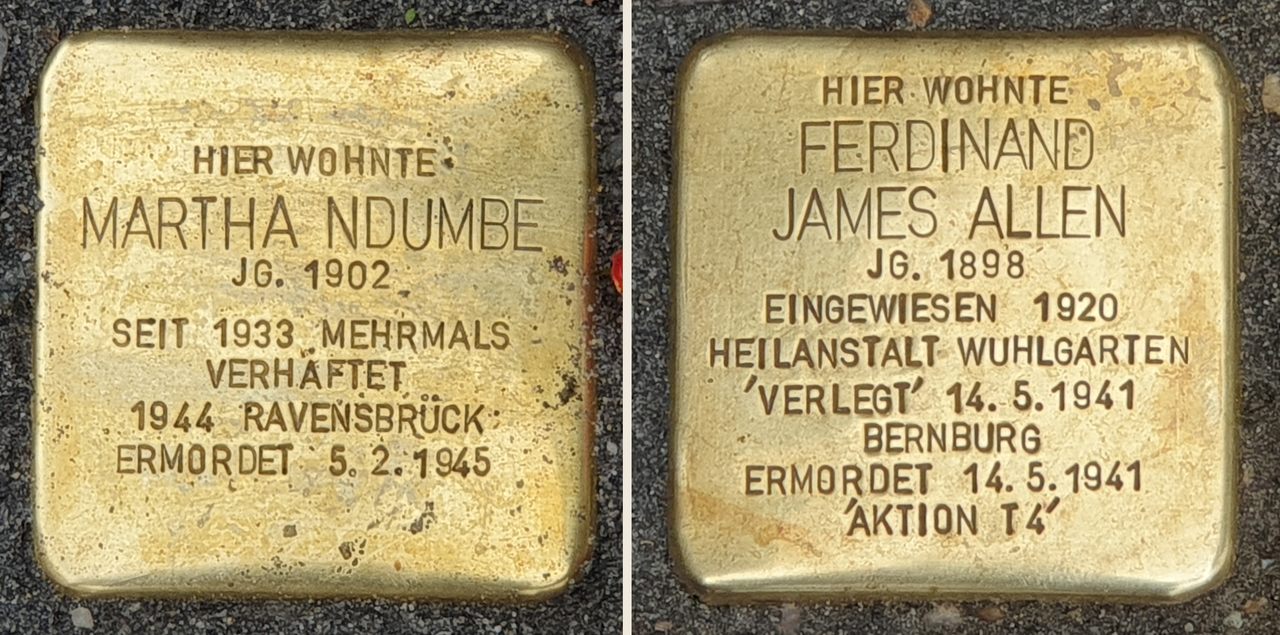The Overlooked History of Berlin’s Black Community
New memorials honor Afro-German victims of the Nazis.
There are more than seventy-five thousand Stolpersteine, or “stumbling stones,” laid into footpaths across Europe. Collectively, it is the largest decentralized memorial of its kind anywhere in the world. Each four-by-four brass stone is placed at the last known residential or working address of a human being who was murdered by the Nazis. Though most of the stones commemorate people who were Jewish, Roma and Sinti, homosexual, or disabled, there were many other groups persecuted by the Nazis–including Black people. In Germany, four of these stones are dedicated to Black victims, two of which were installed in Berlin in 2021. They belong to Martha Ndumbe and Ferdinand James Allen.
“The Black victims of the Nazis have long not been considered—neither by academic research nor by memorial politics,” says Sophia Schmitz from the Coordination Office Stolpersteine Berlin. “But in a town like Berlin a Black community in the 1920s and 1930s did exist, all of whom were at first harassed and later more often than not murdered during Nazi rule. It is our aim to uncover their stories and make them present again, late as it is.”
Dr. Robbie Aitken, a professor at Sheffield Hallam University and author of Black Germany: The Making and Unmaking of a Diaspora Community 1884 - 1960, coordinated the initiative to lay Ndumbe’s and Allen’s stones with support from the Stolpersteine office and Dekoloniale, a Berlin-based project that is examining Germany’s colonial history and its consequences. Both Ndumbe and Allen lived in Berlin during World War II, but Aitken says that they were also part of a larger Black community that existed in Germany dating back to even before World War I, many of whom were people from German colonies in Africa, as well as other African countries. Most of them lived and worked in Europe as performers in the Völkerschauen–or human zoos–large ethnological exhibitions that featured Africans in tribal dress that perpetuated stereotypes of African life and reinforced a sense of German racial superiority.
“Pre-1914, we are talking about several thousand people–but they’re very transient. If they were part of a human zoo, they wouldn’t stay long,” says Aitken. “They’d tour Berlin, Hamburg, then maybe Budapest, Paris.”

This was the case for Martha Ndumbe’s father, who came from Cameroon to Germany for The First German Colonial Exhibition in Berlin in 1896. Afterwards, he stayed in Berlin, where his daughter was born in 1902. But as was the case for many Afro-Germans at the time, life in Germany for her was very difficult and, unable to find work, she turned to prostitution as a means of survival–a profession that the Nazis labeled as “antisocial.” She was murdered at Ravensbrück concentration camp in 1945. Her Stolperstein is laid at her last place of residence, Max-Beer-Straße 24 in Berlin’s Mitte district.
There were approximately 400 human zoos in Germany up until the 1930s. But those weren’t the only jobs available to Africans living in Germany at the time. Aitken says that many Africans came to Germany to strengthen diplomatic ties or as servants for colonial traders and missionaries, and some even came from the upper echelons of African society.
“They were not all necessarily from poorer families,” says Aitken. “Some of them came from the African elite. They placed their children in the care of Europeans as a way of cementing a developing colonial relationship.”
After World War I broke out, Aitken says that the transient community became a fixed population, since the channels that one might normally use to return to Africa were no longer available. “If you were stuck in 1914, then you’re stuck. That was when we started to see families starting to develop and networks expanding. But the growth stopped, because Germany lost the colonies [in the Treaty of Versailles in 1919] and people stopped coming from Cameroon, Togo, and Africa in general.”
After World War I, a number of factors led to the proliferation of racist images of African Germans. Chief among them was resentment from Germany’s defeat and the country’s subsequent economic hardship.
“It’s when you get to the 20s, when you had hyperinflation that the situation deteriorated and you got this savagely racist Schwarze Schmach [Black Shame] propaganda, that the crass racial stereotypes became more fixed,” Aitken says.

He is referring to the period in the early 1920s when approximately twenty-five thousand French colonial soldiers from Africa occupied Germany west of the Rhine river, the majority of whom came from Algeria, Morocco, and Tunisia, fathering approximately six hundred to eight hundred children with white German women. The Reich Chancellery worked with other groups to propagandize these relationships with images that turned the African soldiers into “barbarians” who had allegedly raped white German women, a strategy that represented the “shame” the country felt living under French occupation–which many felt was nothing short of a national disgrace.
The resentment from this occupation, in combination with Germany’s economic difficulties after the First World War, played a strong role in the proliferation of racist images that were later weaponized to support racist Nazi ideology and formally solidified in the 1930s when the Nuremberg Laws were passed which, while initially applied to Europe’s Jewish communities, were later expanded to include Black people among other marginalized groups.
From the late 1920s to the early 1930s, Aitken says that racism for Black people in Germany increased significantly. One example is the children of the aforementioned relationships, who were later given the derogatory name of the Rheinlandbastarde, or “Rheinland bastards,” and in 1937, Nazi officials ordered them all to be sterilized. This was a horrific fate that many Afro-Germans in the wider community were also subjected to–including Ferdinand James Allen. Born in 1898, he was the son of a Black-British musician and a white German mother from Berlin. Allen, who also suffered from epilepsy, struggled growing up as a Black person in Germany. In 1935, he was sterilized* under the racist Law for the Prevention of Hereditarily Diseased Offspring and was later killed at Bernburg Psychiatric Hospital in 1941 as part of the Nazis’ T4 Campaign, an involuntary “euthanasia” mass murder that targeted people living with physical and mental illness. His Stolperstein is also laid in front of his last place of residence in Berlin’s Mitte district, at Torstraße 176 - 178.

Aitken felt that it was important to tell these stories and so, along with the Stolpersteine office, he got in touch with Christian Kopp of Dekoloniale. Kopp says that stories like Ndumbe’s and Allen’s are often left out of wider conversations about the extent of the Nazis’ crimes. That’s why the Dekoloniale team supported the initiative to install the new stones.
“This is an important thing to show, especially how it’s related to this debate concerning the continuities of colonial genocide into the genocide of the Nazi regime,” he says. “It’s important to know that there were Black victims of Nazism and that they were again imprisoned and killed in concentration camps. They were included in the racist, deadly ideology of the Nazis. It tends to be left out of the picture, I’m afraid.”
So far, there are only four Stolpersteine in Germany dedicated to Black victims. Aside from Ndumbe and Allen, Berlin also has a third stone dedicated to Mahjub bin Adam Mohamed, whose stone lies at Brunnenstraße 193, his last place of residence. And the fourth belongs to Hagar Martin Brown, which lies at Marburgerstraße 9 in the city of Frankfurt, his last place of residence where he lived with his wife and children. Aitken believes there were probably a lot more. Finding the evidence, he says, is the difficult part.

“There were a lot of people who died during the Nazi period, who were likely murdered. But proving that they were murdered or that they were sterilized is pretty difficult because of the lack of documents. If a Black person is in the hospital in 1942 and dies at the age of 38, that looks highly suspicious to me. But that doesn’t mean that they were murdered.”
As public knowledge of the lives of Afro-Germans during that era continues to grow, Aitken has hopes that these stones may show others that Black people lived in Germany under Nazism and that they too suffered. “Pursuing the Stolpersteine was partly about honoring Martha and Ferdinand, but it was also about calling into question the people who think that there’s an ambiguity and that Black people weren’t victims.”
Correction: An earlier version of this story misstated the year Ferdinand James Allen was sterilized.




















Follow us on Twitter to get the latest on the world's hidden wonders.
Like us on Facebook to get the latest on the world's hidden wonders.
Follow us on Twitter Like us on Facebook